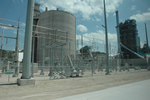 |
| Opened in 2010, the Holcim (US) Ste. Genevieve, Mo., plant was built to power efficiency standards destined to pace Energy Star thresholds for cement production, and is one of five company sites EPA recognized for 2015 performance. The 4 million ton/year capacity operation lies along the Mississippi River on a 2,000-acre site one hour south of St. Louis. |
Twenty-seven portland cement operations are among 70 manufacturing plants to achieve Environmental Protection Agency Energy Star certification in 2015. Producers recognized for achieving energy performance in the top 25 percent of the industry are Holcim (five plants); Buzzi Unicem, Cemex USA and Lehigh Cement (four plants); Argos USA, Essroc Cement and Titan America (two plants); plus, Ash Grove Cement, CalPortland Co., Martin Marietta Materials, Salt River Materials and Suwannee American (one plant).
“Energy Star certified manufacturing plants are driving the kinds of efficiencies and innovations that keep our country strong,” says EPA Administrator Gina McCarthy. “They’re proving every day that businesses can save on energy, cut down on bills, and reduce greenhouse gas emissions all at the same time.”
Independently verified energy efficiency measures at the cement and other plants recognized in the 2015 Energy Star manufacturing program netted power consumption savings of $475 million, EPA estimates, and reduced greenhouse gas emissions by 5 million-plus metric tons. The agency has certified manufacturing plants with the Energy Star for reaching the top quartile of energy performance in their industries nationwide since 2006. In addition to cement, other sectors represented among the 70 plants certified for 2015 are automotive, corn refining, food processing, glass manufacturing, pharmaceuticals, and petroleum refining.
Throughout 2016, certified plants will be hosting events to showcase energy-saving strategies; scheduled activities will be posted at www.energystar.gov/industrialshowcase. Since the inception of EPA’s Energy Star certification, a total of 148 manufacturing plants have been recognized. By agency estimates, they have saved over 618 trillion British thermal units (TBtu) in energy, equal to a) preventing more than 41 million metric tons of carbon dioxide equivalent emissions; and, b) powering the electricity needs for approximately 3.5 million American households.
EPA provides industry-specific Energy Star plant benchmarking tools to help measure energy performance for companies in the 11 sectors; they allow companies to compare a plant against peer operations and empower participants to set informed improvement goals.
ENFORCEMENT PRIORITIES: INDUSTRIAL WATER POLLUTION, CHEMICAL RELEASES
As part of a three-year review, the Environmental Protection Agency has finalized its National Enforcement Initiatives for 2017-2019, approaching the next cycle, October 1 (FY2017 start) with one expanded and two new targets, plus perennial priorities:
- Keeping industrial pollutants out of the nation’s waters (new);
- Reducing risks of accidental releases at industrial and chemical facilities (new);
- Cutting hazardous air pollutants (expanded);
- Reducing air pollution from the largest sources;
- Ensuring energy extraction activities comply with environmental laws;
- Keeping raw sewage and contaminated stormwater out of the nation’s waters; and,
- Preventing animal waste from contaminating surface and ground water.
“These were chosen so we can better protect communities, especially those overburdened by pollution, and were informed by extensive analysis and public input,” says Assistant Administrator for Enforcement and Compliance Assurance Cynthia Giles. “We remain committed to a vigorous enforcement program that reduces pollution and protects public health.”
EPA draws National Enforcement Initiatives on three-year cycles to focus resources on national environmental problems where there is significant non-compliance with laws and federal efforts can make a difference, she adds. The initiatives will focus on employing Next Generation Compliance strategies through which EPA utilizes new tools to increase compliance and vigorously enforce environmental laws.
Target areas where National Enforcement Initiatives has spurred significant progress, the agency notes, include combined sewer systems: More than 98 percent of cities with such infrastructure and 90 percent of cities with large sanitary sewer systems are under enforceable agreements or have permits that put them on schedule to address untreated sewage discharges to American waterways.
